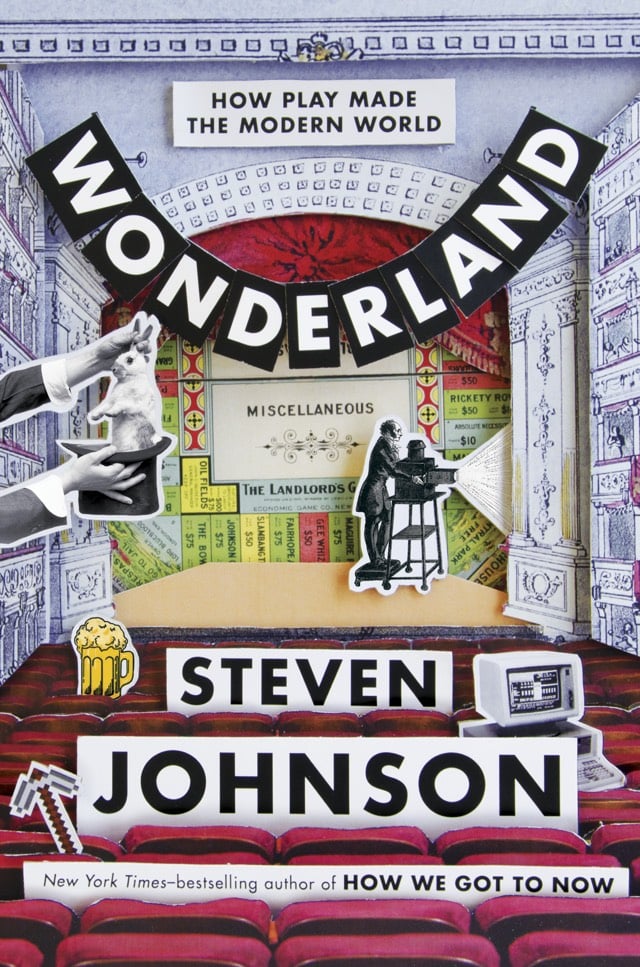Wonderland: How Play Made the Modern World
Steven Johnson’s new book, Wonderland: How Play Made the Modern World, will be out in November. In it, he describes how novelties and games have been responsible for scientific innovation and technological change for hundreds of years.
This lushly illustrated history of popular entertainment takes a long-zoom approach, contending that the pursuit of novelty and wonder is a powerful driver of world-shaping technological change. Steven Johnson argues that, throughout history, the cutting edge of innovation lies wherever people are working the hardest to keep themselves and others amused.
Johnson’s storytelling is just as delightful as the inventions he describes, full of surprising stops along the journey from simple concepts to complex modern systems. He introduces us to the colorful innovators of leisure: the explorers, proprietors, showmen, and artists who changed the trajectory of history with their luxurious wares, exotic meals, taverns, gambling tables, and magic shows.
Here’s Johnson’s introduction on How We Get To Next.
They all revolve around the creative power of play: ideas and innovations that initially came into the world because people were trying to come up with fresh ways to trigger the feeling of delight or surprise, by making new sounds with a musical instrument, or devising clever games of chance, or projecting fanciful images on a screen. And here’s the fascinating bit: Those amusements, as trivial as they seemed at the time, ended up setting in motion momentous changes in science, technology, politics, and society.
[Ok, riff mode engaged…I have no idea if Johnson talks about learning while playing in his book, but I’ve been thinking about this quite a lot lately so…ready or not, here I come.] Being the parent of young children, you hear a lot about the power of play. I’ve never been a fan of a lot of screen time for kids, but lately I’ve been letting them play more apps on the iPad and also Mario Kart 8 on the Wii U. I’ve even come to think of their Kart playing as educational as well as entertaining. Watching them level up in the game has been fascinating to watch — Minna (my almost 7-year-old) has gone from not even being able to steer the kart to winning Grand Prix gold cups at 50cc (and she’s a better shot with a green shell than I am) and Ollie (my 9-year-old) is improving so rapidly that with his superior neuroplasticity and desire, he’ll be beating me in just a few months.1
Ok, but what is Mario Kart really teaching them? This isn’t about preparing them for their driver’s license exam. As dumb as it sounds,2 Mario Kart is a good vehicle (har!) for learning some of life’s most essential skills. They’re learning how persistant practice leads to steady improvement (something which isn’t always readily visible with schoolwork). They’re learning how to ignore what they can’t control and focus on what they can (Minna still watches green shells after shooting them but Ollie no longer does…helloooooo Stoicism). They’re learning how to lose gracefully and try again with determination. Most of all, they’re learning how to navigate an unfamiliar system. Teaching someone how to learn — knowing how to learn things is one of life’s greatest superpowers — is about exposing them to many different kinds of systems and helping them figure them out.
Update: Johnson is hosting a podcast based on the ideas in the book.
Update: Wonderland is now on sale. Johnson adapted an essay from the book on Medium called Small World After All:
The first group to build a single integrated system for global trade were the Muslim spice merchants who came to prominence in the seventh century CE. Muslim traders worked the entire length of a network that stretched from the Indonesian archipelago to Turkey and the Balkans all the way across sub-Saharan Africa. Alongside the cloves and cinnamon, they brought the Koran. In almost all the places where Muslims attempted to convert local communities through military force — Spain or India, for instance — the Islamic faith failed to take root. But the traders turned out to be much more effective emissaries for their religion. The modern world continues to be shaped by those conversions more than a millennium later. The map of the Muslim spice trade circa 900 CE corresponds almost exactly to the map of Islamic populations around the world today.
He also wrote a piece adapted from the book for the NY Times Magazine:
By the dawn of the 20th century, almost every species in the 19th-century genus of illusion was wiped off the map by a new form of “natural magic”: the cinema. The stereoscope, too, withered in the public imagination. (It lingered on as a child’s toy in the 20th century through the cheap plastic View-Master devices many of us enjoyed in grade school.) But then something strange happened: After a century of irrelevance, Brewster’s idea — putting stereoscopic goggles over your eyes to fool your mind into thinking you are gazing out on a three-dimensional world — turned out to have a second life.
Ok, maybe in a year or two. Old Man Kottke is pretty good at Kart and has a few tricks left up his sleeve. Wisdom and experience can often be more than a match for youthful brilliance. ↩
It’s a bummer to have to caveat this. Even in the age of Minecraft, video games aren’t often thought of as learning opportunities. Very few in the US would bat an eyelash if I were talking about basketball or Little League. ↩






Stay Connected